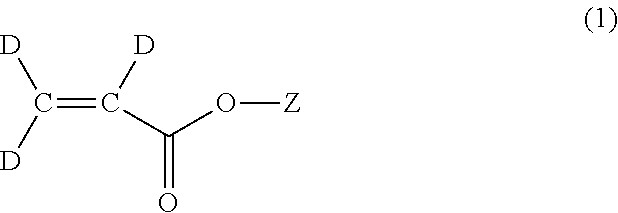Methods for the synthesis of deuterated acrylate salts
a technology of deuterated acrylate salt and synthesis method, which is applied in the field of polymerizable deuterated monomers and methods of preparation, can solve the problems of limited small scale production, high cost of key monomers such as dsub>3 /sub>(dsub>2/sub>ccd-cosub>2/sub>h), and the current method of making deuterated acrylate salt and the corresponding acid, etc., to redu
- Summary
- Abstract
- Description
- Claims
- Application Information
AI Technical Summary
Benefits of technology
Problems solved by technology
Method used
Image
Examples
example 1
Preparation of Sodium Propiolate by Exchange Reaction of Step (i)
[0047]The general reaction scheme for step (i) is provided as follows:
[0048]Step (i) involves exchanging the weakly acidic methyne proton with a deuteron by two or three successive contacts of about 1 g of sodium propiolate dissolved in about 1.5-2.2 g of deuterium oxide (at least 1.5 g D2O is needed to conveniently dissolve 1 g of sodium propiolate). A small amount of the base sodium carbonate (10 mM in the deuterium oxide for the first contact) was herein found to facilitate the H / D exchange. Other bases, such as sodium hydroxide, potassium hydroxide, and potassium carbonate can be used, but the non-protic carbonate bases are preferred, and sodium carbonate is most preferred. After equilibrium is achieved, the DHO / D2O mixture can be recovered by vacuum distillation (such as by rotary evaporation), and fresh D2O added to the solids that remain, which includes the sodium carbonate. Typically, for two contacts with 2.2 ...
example 2
Preparation of Sodium Acrylate by Reductive Hydrogenation Process of Step (ii)
[0052]The general reaction scheme is provided as follows:
[0053]In the second step, the alkyne group of sodium propiolate-d is partially reduced to an alkene group using deuterium gas to afford sodium acrylate-d3 (D2C═CD-CO2Na). Although the catalyst system used for this transformation is the well-known Lindlar catalyst (5 wt % Pd(0) supported on calcium carbonate or barium sulfate with usually 3 wt % of lead carbonate of lead sulfate) in combination with the organic base quinoline, it has herein been discovered that there is a narrow set of reaction conditions that can be used to afford the desired D2C═CD-CO2Na product in a facile manner in high yield, and without excessive over-reduction to sodium propionate-d5, CD3CD2-CO2Na.
[0054]The main variables in the reductive deuteration reaction include: a) the quality and concentration of the Lindlar catalyst, b) the concentration of deuterium gas a...
example 3
Experiments Comparing Hydrogen Vs. Deuterium Incorporation During Catalytic Reduction of Sodium Propiolate to Sodium Acrylate
[0068]A 250-mL round bottom flask was charged with either sodium propiolate (2-Na, 1.15 g, 12.5 mmol) or sodium propiolate-d (3-Na, 1.16 g, 12.5 mmol), Lindlar catalyst (200 mg), hydroquinone (10 mg), and a Teflon-coated stir bar. Methanol or methanol-d (40 mL) was added and the solution stirred to dissolve the propiolate, followed by 0.10 mL of quinoline. The flask was sealed with a rubber septum, sealed with parafilm, and evacuated and N2 back-filled three times by means of a needle attached to a double-manifold vacuum line. A plastic 5-mL syringe barrel with the large end cut off was fitted with two He-quality latex balloons (one balloon inserted inside a second balloon), using rubber bands and parafilm. The balloon assembly was purged with nitrogen at least three times. The syringe barrel of the evacuated / deflated balloon assembly was fitted with a needle ...
PUM
| Property | Measurement | Unit |
|---|---|---|
| Fraction | aaaaa | aaaaa |
| Fraction | aaaaa | aaaaa |
| Fraction | aaaaa | aaaaa |
Abstract
Description
Claims
Application Information
 Login to View More
Login to View More - R&D
- Intellectual Property
- Life Sciences
- Materials
- Tech Scout
- Unparalleled Data Quality
- Higher Quality Content
- 60% Fewer Hallucinations
Browse by: Latest US Patents, China's latest patents, Technical Efficacy Thesaurus, Application Domain, Technology Topic, Popular Technical Reports.
© 2025 PatSnap. All rights reserved.Legal|Privacy policy|Modern Slavery Act Transparency Statement|Sitemap|About US| Contact US: help@patsnap.com



